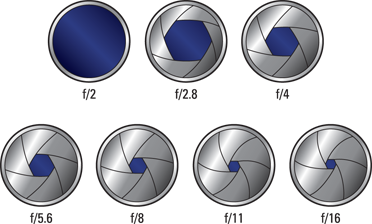Getting Yourself Up to Speed on Exposure and Camera Settings
After you’ve amassed your photography gear, the next step to getting yourself ready to shoot weddings is making sure you have the knowledge and skills needed to actually take good photos! In this section, I go over the basics of exposure and different camera settings you should know.
Exploring the basics of exposure
Exposure deals with the amount of light that is permitted to fall on your sensor. That light is regulated by three things in your camera: aperture, shutter speed, and ISO.
Examining aperture
Aperture refers to the size of the opening in your lens through which the light travels to the sensor. The larger the opening, the more light comes through. The smaller the opening, the less light that comes through. The sizes of the aperture are called f-stops and are expressed as f/number, such as f/1.2, f/2.8, f/4, f/16, f/22.

Illustration by Wiley, Composition Services Graphics
Figure 2-8: A larger f-stop number means a smaller ...
Get Digital Wedding Photography For Dummies now with the O’Reilly learning platform.
O’Reilly members experience books, live events, courses curated by job role, and more from O’Reilly and nearly 200 top publishers.
 Here’s where the numbers can get a little confusing: A larger f-stop number, like f/22, means a smaller aperture, whereas a small f-stop number, like f/1.2, is a very large aperture (check out
Here’s where the numbers can get a little confusing: A larger f-stop number, like f/22, means a smaller aperture, whereas a small f-stop number, like f/1.2, is a very large aperture (check out 
